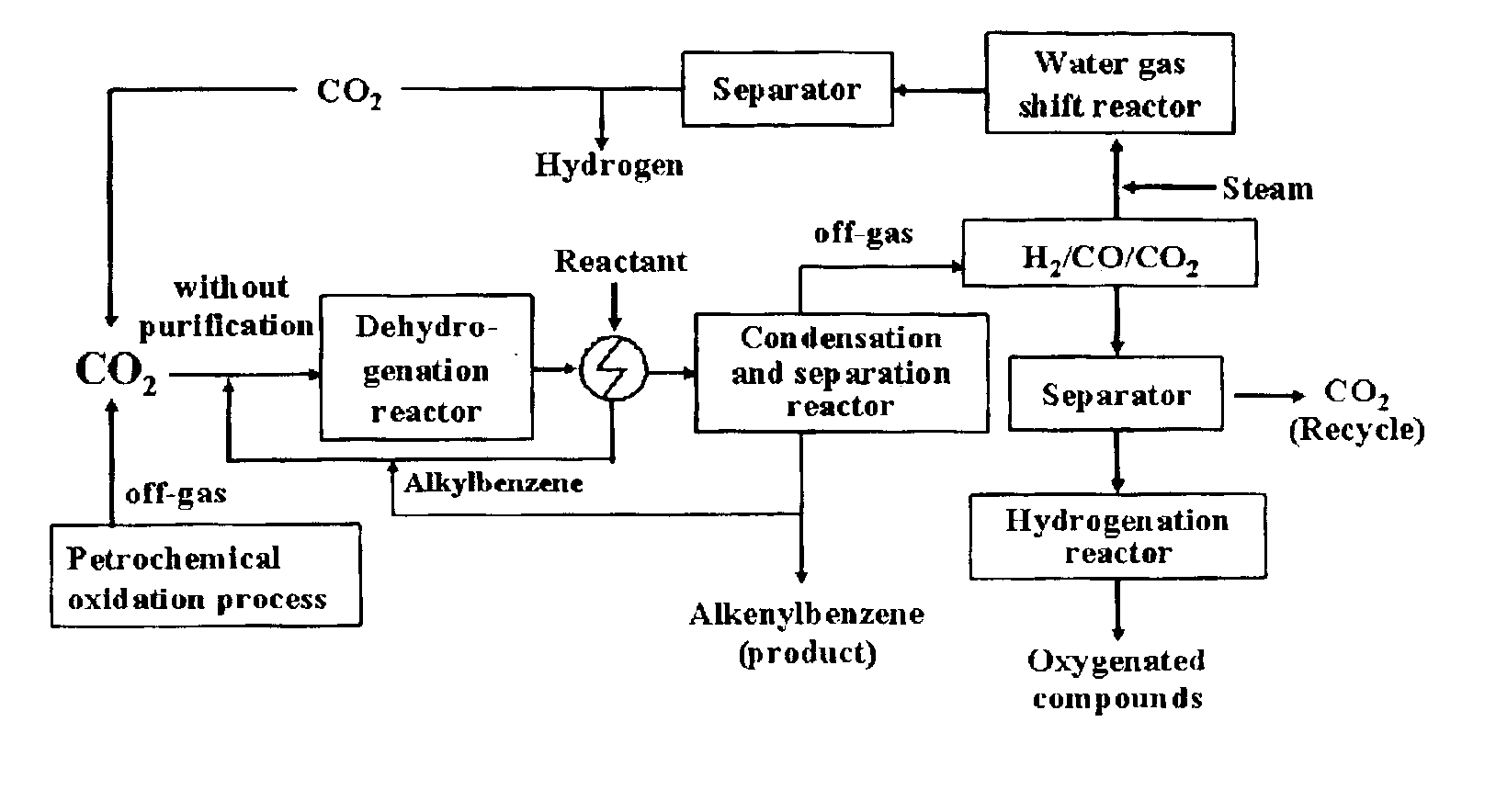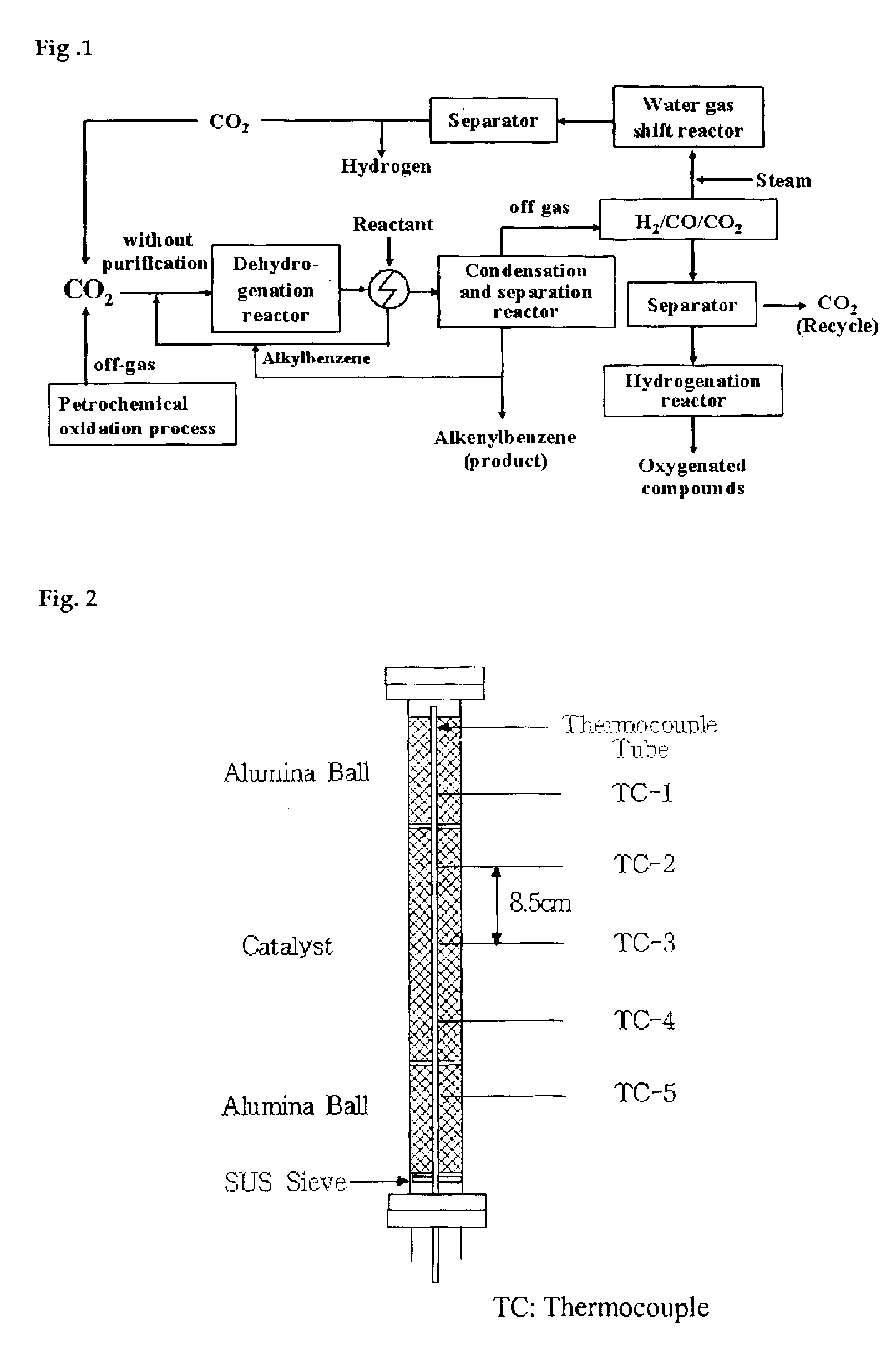Method for catalytic dehydrogenation of hydrocarbons using carbon dioxide as a soft oxidant
- Summary
- Abstract
- Description
- Claims
- Application Information
AI Technical Summary
Benefits of technology
Problems solved by technology
Method used
Image
Examples
example 1
[0022]Example 1 is a dehydrogenation reaction of ethylbenzene to styrene using carbon dioxide in the presence of a catalyst having a spherical shape of 3 mm in size wherein vanadium, iron and antimony are impregnated onto a zirconia-alumina support that contains 10 wt. % of zirconia (hereinafter referred to as V—Fe—Sb / ZrO2—Al2O3). The catalyst used in Example 1 was prepared from SbCl3 precursor by using a zirconia-alumina support via sol-gel method (diameter: 3 mm; BET specific surface area: 165 m2 / g). The contents of vanadium, iron and antimony in the above catalyst were used in the range of 1-15 wt. %, 1-15 wt. % and 20 wt. %, respectively, based on oxides. The catalyst were prepared by the following method: all the precursors of the constituents of the catalyst except support were dissolved in distilled water at 25° C. so that the concentration of metals became 1 M. Tartaric acid having the same mole as those of added metal salts was added to the mixture and dissolved completely ...
example 2
[0032]In this Example, the dehydrogenation reaction of p-ethyltoluene to p-methylstyrene using carbon dioxide over the same catalyst as Example 1 was performed using the microcatalytic testing unit, wherein a fixed bed reactor made of quartz was vertically installed. The reaction conditions were set as follows: (1) the WHSV was set at 1 per hour; (2) the molar ratio between carbon dioxide and p-ethyltoluene was 20:1; and (3) the reaction temperature was 500° C. The reactant mixture was reacted under atmospheric pressure and the total partial pressure of ethylbenzene and carbon dioxide was set to 0.75 atm by diluting with nitrogen. The conversion of p-ethyl toluene was 39.5% and the selectivity of p-methyl styrene was 95.6%.
example 3
[0034]The dehydrogenation reaction of diethylbenzene was performed using carbon dioxide in the same reaction apparatus using the same catalyst (V—Fe—Sb / ZrO2—Al2O3) as in Example 2. The reaction conditions were set as follows: (1) the WHSV was set at 1 per hour; (2) the molar ratio between carbon dioxide and diethylbenzene was 1:1; and (3) the reaction temperature was set at 540° C. The conversion of diethylbenzene was 76.1% and the selectivity to divinylbenzenes was 45.4%.
PUM
| Property | Measurement | Unit |
|---|---|---|
| Percent by mass | aaaaa | aaaaa |
| Fraction | aaaaa | aaaaa |
| Fraction | aaaaa | aaaaa |
Abstract
Description
Claims
Application Information
 Login to View More
Login to View More - R&D
- Intellectual Property
- Life Sciences
- Materials
- Tech Scout
- Unparalleled Data Quality
- Higher Quality Content
- 60% Fewer Hallucinations
Browse by: Latest US Patents, China's latest patents, Technical Efficacy Thesaurus, Application Domain, Technology Topic, Popular Technical Reports.
© 2025 PatSnap. All rights reserved.Legal|Privacy policy|Modern Slavery Act Transparency Statement|Sitemap|About US| Contact US: help@patsnap.com


